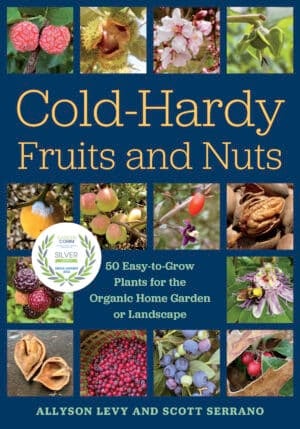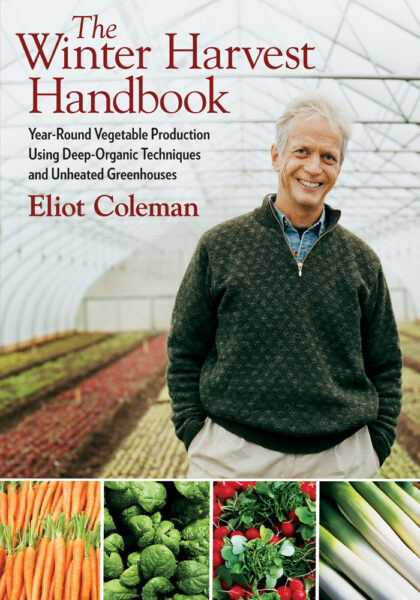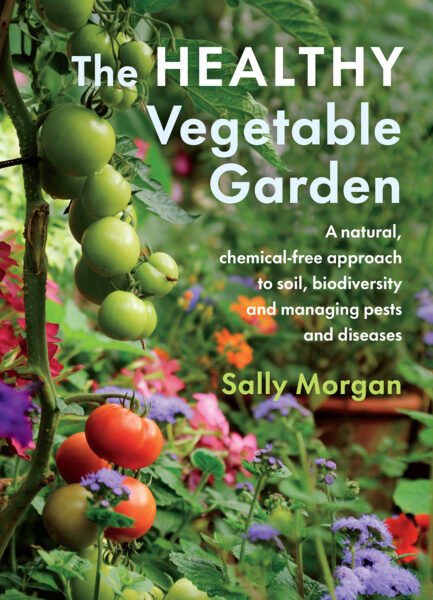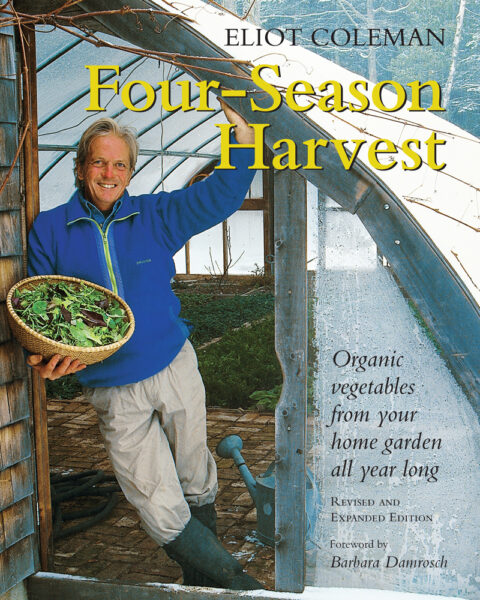How to Protect Plants from Winter Elements
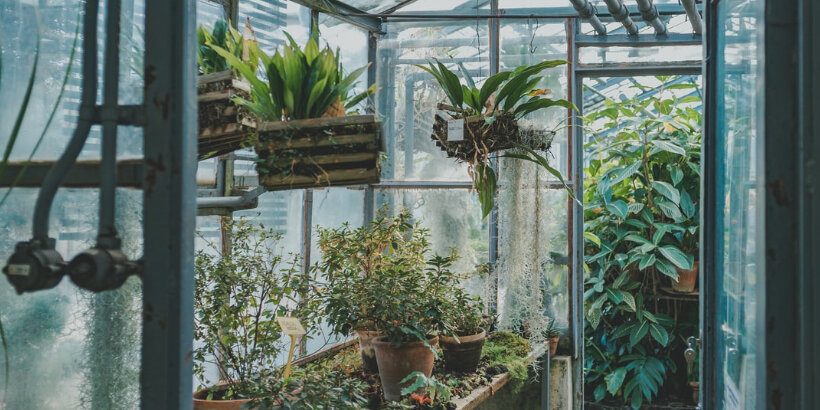
Living in a colder climate doesn’t mean you need to give up on more fragile plants. By adequately preparing your less-hardy plants for the winter, you’ll set them up to survive and thrive!
The following is an excerpt from Cold-Hardy Fruits and Nuts by Scott Serrano and Allyson Levy. It has been adapted for the web.
Protect Plants from Winter Elements
Anyone who has tended a garden in the northern parts of the United States over several years understands that each growing season is distinct because of the vagaries of the weather. While each season has similar qualities to those of the year before, no two years are exactly alike.
Some winter seasons bring massive amounts of snow and abnormally cold weather, while others deliver only a few inches of snow. All the combined elements of snow, wind, temperature, sun exposure, and fluctuations between winter and spring affect the plants in a garden.
Those readers who live where winter temperatures do not fall below 10°F (−12°C) might not need to worry as much about the winter protection measures listed below. When a tree or shrub is young and has only been in the ground for a single growing season, it is vulnerable to winter damage.
Protecting Different Types of Plants
While some plants are tough and adaptable, others are more fragile and may need a few years of extra protection to survive the winter. The suggestions below are a range of options that you can employ for a single tree or for multiple plantings that would benefit from a year or two of extra protection before being exposed to the full impact of a northern winter.
Many may find that lavishing extra winter care on new plants is excessive. The degree to which you protect a young planting that may not be completely hardy can range from doing nothing to constructing a small temporary enclosure. We have listed some options below ranked from the simplest to the most complex.
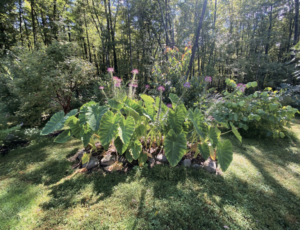 Protective Mulching
Protective Mulching
The easiest way to reduce the negative effects of low winter temperatures on a young plant is a thick layer of mulch over the root system. Any mulch of mixed wood chips or shavings will cushion a young plant’s roots against winter temperatures. This extra mulch can be piled high against a plant’s trunk or branches for protection as an insulation blanket over the root system.
Then in spring the excess mulch must be cleared away from directly touching the trunk and spread out evenly in a thin layer in order to cover the roots. Because thick layers of mulch provide cover for small rodents, it’s important to use a protective tree collar so that animals cannot damage the new plant.
Winter Sunscald
Woody deciduous plants survive the winter months by going into a period of dormancy—the state in which a plant is alive but not actively growing. This is triggered by a combination of the autumn cold and the shortening day length. Toward the end of winter, as day- time temperatures begin warming up, deciduous plants can sometimes start to wake from their dormancy period while the land is still in the grip of winter, and this can cause damage.
Warm daytime temperatures cause the frozen sap near the roots of a woody plant to rise up the trunk toward the buds on the ends the branches. Because it’s winter, though, nighttime temperatures can still drop below freezing.
Sap & Sunscald
The sap that has risen up the trunk can suddenly freeze before it has enough time to travel back down to the roots. When the temperature warms up again, the trapped frozen sap expands, splitting the trunk open under the pressure. This is called southwestern syndrome or sunscald, and it is exemplified by cracks that run down the bark of a plant on the side with the sunniest exposure, typically facing the southwest.
Sunscald is most prevalent in young trees with long trunks that contain thin, flexible bark that are planted in full-sun sites facing a southern or southwestern exposure. A traditional method for dealing with this is by painting the trunks of young trees with a thin layer of white paint diluted with water.
Painting Tree Trunks
The theory is that the young plant’s white-painted bark reflects sunlight away from the trunk, slowing the warming of the tree’s sap. Take water-based white house paint and thin it with water at a ratio of 1 part paint to 4 parts water, then apply a few thin coats of paint from the tree trunk’s bottom to the first major branches.
The primary drawback is that the tree’s bark will look chalky white and less aesthetically pleasing. However, as the plant matures the paint slowly fades, and splitting tends to happen less as the tree develops thicker bark.
Wrapping Plants
An old-fashioned way of protecting plants is to wrap them with burlap. This will provide some protection from the cold, but is best used at planting sites that have extremely windy conditions where the branches of plants can be damaged by desiccation (drying out).
This method of protection can also be used to protect shrubs planted closely together in a hedge. Wrap the burlap firmly around the sides of the hedge as a large protective layer against heavy snow loads.
Tenting
You can construct a temporary tent around a shrub or small tree to create a mini greenhouse environment through the winter. A protective tent enclosure can be a simple “tepee,” formed out of thin wooden posts or bamboo stakes driven into the ground and tied together on top. You then wrap a transparent plastic sheet around the entire structure.
Remove the covering in early spring before the temperatures get too warm. Remember that any warm protective space for a plant is also a warm protective space for small mice and voles, which may chew on the lower sections of the plant. If mice and voles are a problem in your region, consider putting a protective vole cover around the plants.
Greenhouse
The largest form of winter protection for growing plants in the cold northern latitudes is a greenhouse/hoop house. Because a greenhouse interior can be 10 to 30°F (5–17°C) hotter than outside temperatures in the daytime, a greenhouse lengthens the growing season. In addition to winter protection, a greenhouse cushions a plant against the wind, snowfall, and icy conditions. Although greenhouses are expensive to build, they can last for decades and allow you to consistently produce food over a longer growing season.
Commercially produced greenhouse kits are available in a wide range of sizes and styles. Because the environment in an unheated greenhouse is warmer than the surrounding landscape, plants that are marginal (one zone warmer than your region) can often be kept alive and produce fruit. Although there are size limitations to growing plants in a greenhouse, fruit trees can survive and produce fruit there through diligent pruning and management.
Recommended Reads
Recent Articles
Garlic mustard: while known as “invasive,” this plant can be consumed in its entirety and has great nutritional value. Plus, the garlic-flavor is a perfect addition to any recipe that calls for mustard! The following are excerpts from Beyond the War on Invasive Species by Tao Orion and The Wild Wisdom of Weeds by Katrina…
Read MoreEveryone loves a refreshing, fermented, nutritious drink…even your garden! Take your fermentation skills out of the kitchen and into the garden by brewing fermented plant juice. The following is an excerpt from The Regenerative Grower’s Guide to Garden Amendments by Nigel Palmer. It has been adapted for the web. How to Make Fermented Plant Juice Fermented…
Read MoreWant to see your crops thrive this upcoming growing season? The key is in soil fertility and health. Spend time maintaining your soil’s health to guarantee bigger and better crops come harvest time! The following is an excerpt from No-Till Intensive Vegetable Culture by Bryan O’Hara. It has been adapted for the web. What Is Soil Fertility?…
Read MoreMany know the effects of catnip on our feline friends, but few realize that catnip has medicinal effects for humans. From stomach aches to reducing fevers, catnip is a versatile herb with many benefits. The next time you grow this plant for your cat you may end up taking a few cuttings for yourself! The…
Read MoreIt’s time to take control of your seeds and become a plant breeder! Saving your seed allows you to grow and best traditional & regional varieties, and develop more of your own. The following excerpt is from Breed Your Own Vegetable Varieties by Carol Deppe. It has been adapted for the web. Becoming A Plant…
Read More

